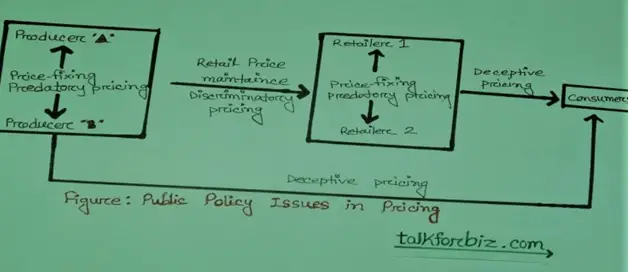Public policy & pricing
In our free market economy, price competition is the core element you survive. Companies are too concerned about setting prices. Our local laws govern the fair pricing strategy. Other hand, companies are also concerned about the societal benefits. For example, pharmaceutical firms must concern about their pricing, they try to balance their development costs & benefit against the life & death needs of drug customers.
The below figure shows the major public policy issues in pricing. This figure defines that potential damaging pricing within a level of channel & across the levels of the channel.

Pricing within channel levels
Our laws allow those producers must set their prices while maintaining the price of their competitors. They should adopt fair pricing. The government should not allow any pricing fixing. If any companies are found guilty of price fixing, they get heavy punishment. Recently, the government enforced price-fixing regulations for every industry ranging from insurance, credit cards, CDs, computer chips, gasoline, etc. In the international markets, price fixing is also prohibited. For example: recently Unilever & P&G get fined by 8 European countries for price fixing in their laundry detergent. France also fined Colgate & Henkel for two consumer products.
Producers also can’t use the below pricing. They can’t reduce their pricing intentionally punishing the competitors. This is called predatory pricing. They mainly do that to get long-run profits by putting competitors out of business. In this way, small sellers get benefited because these rules protect them from larger ones.
At the present time, many large & powerful firms have been accused of predatory pricing.
Pricing across channel levels
There is some action that tries to prevent unfair price discrimination. They try to ensure that sellers offer the same price to all types of customers. In some cases, price discrimination is allowed, if the seller can prove that its costs are different when selling to different customers. For example: if any product that reduces its price can get a higher volume of sales. The seller can discriminate in the cases of the higher quality of the product for different customers. But in these cases, the seller has to prove these differences. Price discrimination is defensive rather than offensive.
Sometimes seller adopts deceptive pricing. This may be three types-
- Deceptive pricing: At first seller announce, that they were reducing pricing but in reality is not match the statement. After that seller states, that fewer prices or price products are not available to customers when they come to buy. This offer is only for confusing customers about price.
- Deceptive promotion: When the seller misrepresents the product features or product performance for confusing customers about the product.
- Deceptive packaging: When the seller exaggerates packet contents like 25% extra in the same price, new design, false labeling, or in packet size.
